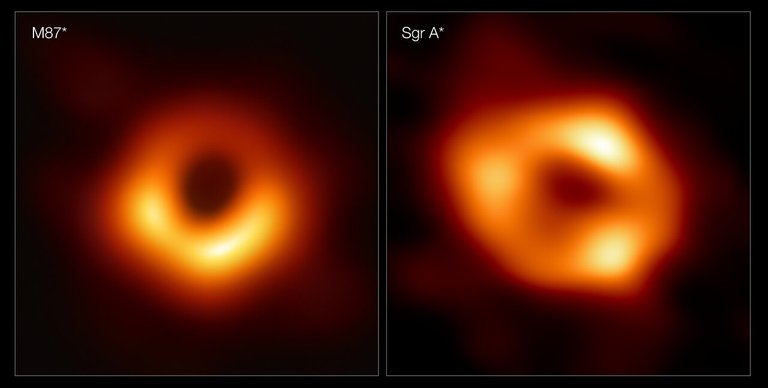
Source
In 2019, the first photograph in the history of a black hole was published, it was M87, a monster with a size of 6,500 million suns located in the center of a giant elliptical galaxy 53 million light years from us, through the international Event Horizon Telescope (EHT) collaboration.
En el año 2019 se publicó la primera fotografía de la historia de un agujero negro, se trataba de M87, un monstruo con un tamaño de 6.500 millones de soles situado en el centro de una galaxia elíptica gigante a 53 millones de años luz de nosotros, mediante la colaboración internacional Event Horizon Telescope (EHT).
For decades astronomers have suspected that there was a black hole in the center of our galaxy and now it seems that they have found it, using the same technology they have managed to photograph the black hole in the center of the Milky Way called Sagittarius A*, located 27,000 light years and with a size of 4 million solar masses.
Durante décadas los astrónomos han sospechado que existía un agujero negro en el centro de nuestra galaxia y ahora parece que lo han encontrado, utilizando la misma tecnología han logrado fotografiar el agujero negro existente en el centro de la Vía Láctea llamado Sagitario A*, situado a 27.000 años luz y con un tamaño de 4 millones de masas solares.

Source
Obviously this image is not the same as a selfie, in order to obtain something so beautiful they have had to process millions of gigabytes of data obtained by radio telescopes located around the world, using an interferometry technique capable of joining the data of all the telescopes and generate a virtual telescope the size of the Earth.
Obviamente esta imagen no es lo mismo que un selfie, para poder obtener algo tan hermoso han tenido que procesar millones de gigabytes de datos obtenidos por radiotelescopios situados en todo el mundo, usando una técnica de interferometría capaz de juntar los datos de todos los telescopios y generar un telescopio virtual del tamaño de la Tierra.
Despite the huge difference in mass between M87 and Sagittarius A, the two black holes have the same apparent size, due to the distance each of them is from us (53 million light years in the case of M87 and 27,000 in the case of Sagittarius A) and this is why they were discovered in the first place.
A pesar de la diferencia de masa descomunal entre M87 y Sagitario A* los dos agujeros negros tienen el mismo tamaño aparente, debido a la distancia a la que cada uno de ellos está de nosotros (53 millones de años luz en el caso de M87 y 27.000 en el caso de Sagitario A*) y esta es la razón de que hayan sido descubiertos en primer lugar.

Source
It should also be borne in mind that these are measurements made with radio telescopes, that is, they are actually invisible to the human eye, so if someone decides to go to see it over the weekend, they probably would not see anything at all, but it provides a large amount useful information for astronomers.
También hay que tener en cuenta que esto son mediciones hechas con radiotelescopios, es decir, que en realidad son invisibles para el ojo humano por lo que si alguien decide acercarse a verlo el fin de semana probablemente no viese absolutamente nada, pero aporta una gran cantidad de información útil para los astrónomos.
A curious fact observed in Sagittarius A* is that, instead of being aligned with the disk of the galaxy as might be expected, it has an inclination of between 30º and 50º with respect to the axis of the galaxy.
But don't worry, despite what we see in the movies, Sagittarius A* won't end up sucking us all out, at least for now.
Un dato curioso observado en Sagitario A* es que, en lugar de estar alineado con el disco de la galaxia cómo se podría esperar, este tiene una inclinación de entre 30º y 50º con respecto al eje de la galaxia.
Pero tranquilos que, a pesar de lo que vemos en las películas, Sagitario A* no acabará succionándonos a todos, al menos por ahora.
More information/Más información
https://www.scientificamerican.com/article/the-first-picture-of-the-black-hole-at-the-milky-ways-heart-has-been-revealed/#:~:text=The%20mystery%20at%20the%20heart,center%20of%20the%20Milky%20Way.
Congratulations @mauromar! You have completed the following achievement on the Hive blockchain and have been rewarded with new badge(s):
You can view your badges on your board and compare yourself to others in the Ranking
If you no longer want to receive notifications, reply to this comment with the word
STOPSupport the HiveBuzz project. Vote for our proposal!
Hola @mauromar, eso da miedo, parece que esos agujeros fuesen como aros de fuego.

That looks wickey and beautiful. I'm glad that really really far away from us, though..